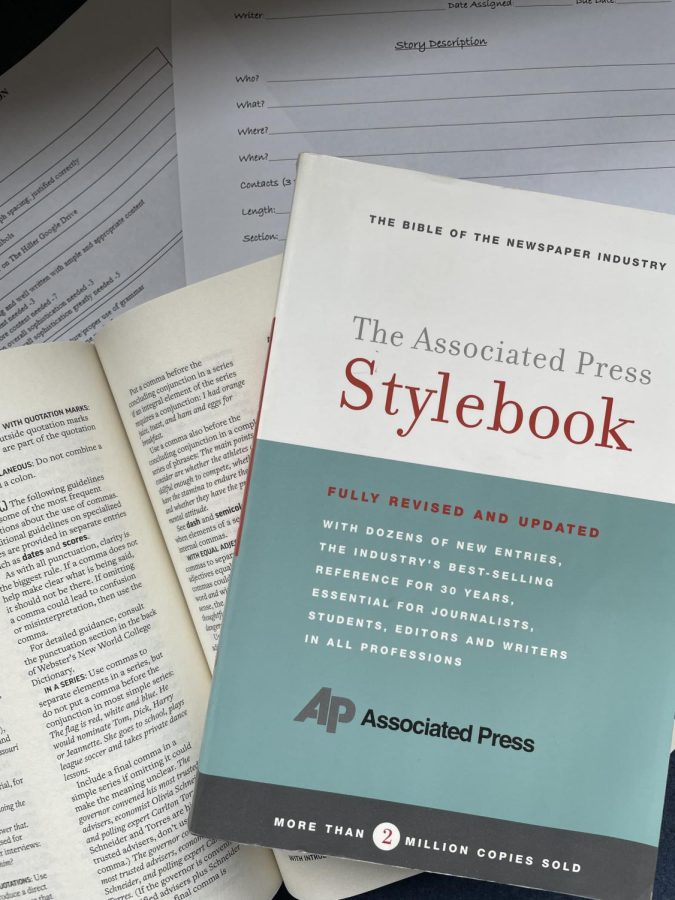Necessary or redundant: settling debate over Oxford comma
Photo courtesy of Hannah Eisiminger
Despite the debate, the Oxford comma is considered optional in American English. Students should consider the circumstances of their work and consult their teachers to determine if the Oxford comma is best for them.
There may be no more polarizing debate in the grammar world than that of the Oxford comma. Since its inception, this specific punctuation mark has caused plenty of controversy among writers and editors across the world. So what exactly is the Oxford comma, and why does it have the English community tied up in a heated debate?
The Oxford comma is the final comma in a series of three or more items. Also called the Harvard comma or serial comma, this punctuation mark occurs just before a conjunction, usually the word “and.”
For example:
Oxford comma: “Trinity seniors will be moving to a number of states for college next year including Connecticut, Arizona, Alabama, Iowa, and Virginia.”
No Oxford comma: “Trinity seniors will be moving to a number of states for college next year including Connecticut, Arizona, Alabama, Iowa and Virginia.”
The world was first introduced to the Oxford comma in 1905 by printer Horace Hart. He published Hart’s Rules for Compositors and Readers during his time as controller of the Oxford University Press (shocker, huh?). This style guide required that his employees use the special comma in all University printings.
Supporters of the serial comma say that it has many advantages, including an increase in clarity and precision. In some cases, the meaning of a sentence can be dramatically changed by omitting a tiny punctuation mark.
For example:
“I’d like to thank my parents, Harry Styles and Taylor Swift.” With no Oxford comma, this sentence can be interpreted as saying that the parents in question are actually Harry Styles and Taylor Swift. While this arrangement sounds like a dream, it is rather illogical in the real world.
Here’s a quick fix:
“I’d like to thank my parents, Harry Styles, and Taylor Swift.” By adding the Oxford comma in this sentence, readers can clearly see that Styles and Swift are being thanked separately from the parents, not that the speaker is the child of two celebrities.
Opponents of the Oxford comma argue that almost all sentences can be restructured to remove the need for the mark. This idea stems from the fact that American English is the only language that uses the serial comma, and other countries appear to have no problem with rephrasing to avoid confusion. This brings up the undeniable irony of British English omitting the Oxford comma, considering the mark’s famous origin.
“I can’t even say that the Oxford comma is outdated because it was useless in the first place. Just restructure the sentence and don’t worry about using a redundant comma,” says Senior Silvio Corso.
Despite the possibility of restructuring, many of the serial comma’s supporters agree that keeping items in a series and adding the Oxford comma is the most efficient way to communicate lists. Additionally, this mark comes in handy when writing speeches as it serves as a cue to pause when reading.
English teacher Mrs. Macino is definitely in favor of the serial comma, stating, “I’d rather have the clarity than the confusion.”
Overall, the Oxford comma takes only a second to add and contributes plenty of clarity to a sentence. The mark is a powerful tool used by people in many professions, including law, advertising and educating, to ensure that their messages are accurately received. Now read that last sentence again. Where is the Oxford comma? Well, that is the second part of the debate.
While many style guides such as MLA, Chicago and APA recommend the use of the Oxford comma, the Associated Press Stylebook used by journalists does not. This style was developed for use in newspapers before online publications were invented. With a printed paper having limited space for each article, every letter and punctuation mark mattered. The AP Stylebook omitted the serial comma for this reason, and the mark is only used when rephrasing cannot be used to clarify meaning. The tradition stuck around when newspapers went digital, much to the dismay of “The Hiller” staff.
“Journalism is meant to be a reflection of real people, and real people naturally pause when they talk and don’t reorder sentences to avoid the comma,” says Senior Staff Writer Aiden DeWalt.
While the debate still rages over the necessity of the Oxford comma, it is important to remember that the mark is considered grammatically optional. The choice to use or omit the comma is left entirely up to the writer and their personal preference. However, writers should beware that their decision on this matter may draw lots of attention from harsh critics or die-hard fans of the Oxford comma, including their beloved English teachers.
Outside of school, Hannah can usually be found catching movies with friends, hiking local trails, wandering around art museums, or grabbing tickets to...






